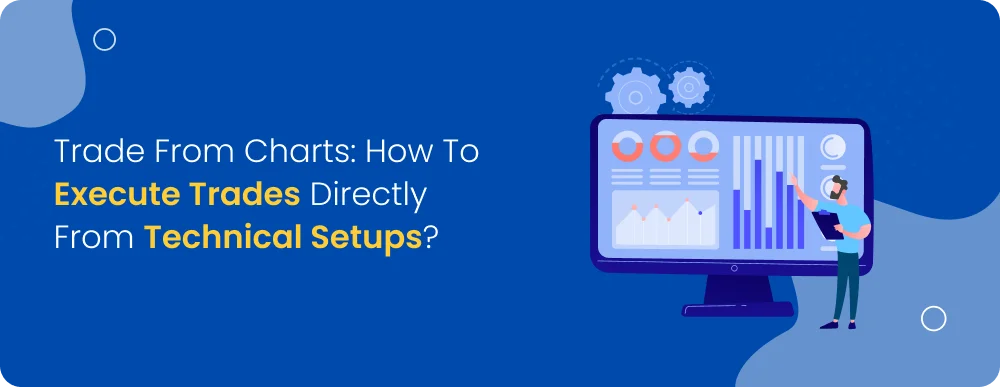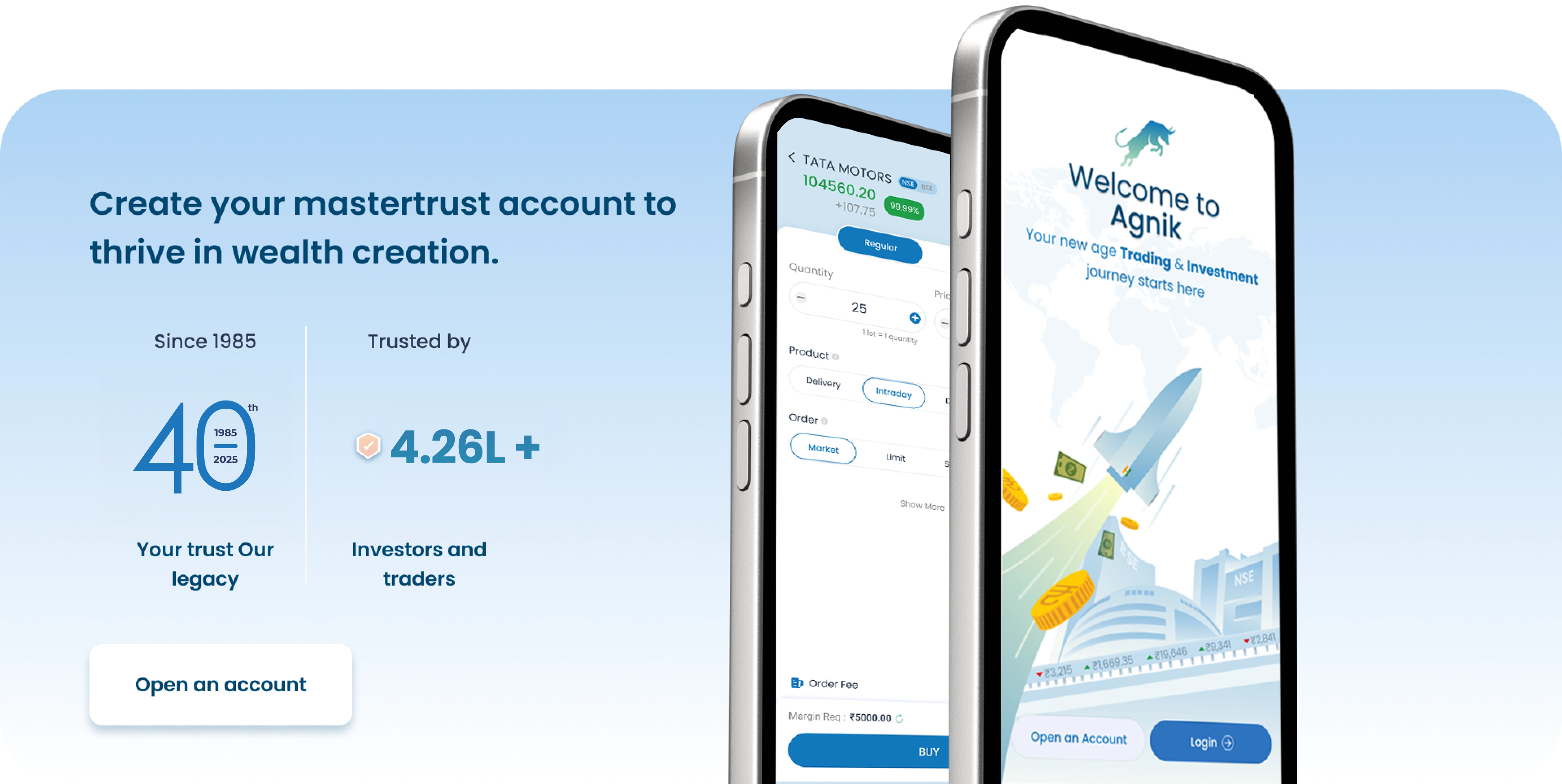Trade From Charts: How To Execute Trades Directly From Technical Setups?
Noor Kaur
25 Jul 2025Tags:
Featured
Chart trading allows you to spot a technical setup and place your or same screen—no switching tabs, no delays. It simplifies execution by letting you act directly on visual cues like chart patterns, support/resistance zones, and indicator signals.
Whether you're trading a breakout or a reversal, chart-based execution keeps your process fast, precise, and structured.
What Is Chart Trading?
Chart trading is a method where you buy or sell directly from a price chart, without switching between windows or tools. You analyse the market chart and place your trades on the same screen. Most traders use chart trading with tools like candlestick charts, line charts, or bar charts to read price movements. This gives you a complete trading chart view of the asset.
You don't just see the price history—you interact with it. Many platforms now allow you to click on the chart to set your entry, stop-loss, and target prices. This makes the trading experience more visual, faster, and more precise.
Benefits of Trading from Charts
Some primary benefits of trading from charts are:
Identify likely future price movements: When you view trading charts—especially candlestick ones—you’ll notice repeating shapes and formations. These are called chart patterns. Experienced traders recognise these patterns and use them to guess where the price might go next. This helps you decide when to buy or sell.
Spot entry and exit points clearly: A market chart shows support and resistance levels. Support is the price level where an asset tends to stop falling. Resistance is where it tends to stop rising. By reading these levels, you can plan your entry (when to buy) and exit (when to sell) more effectively, especially in intraday trades.
Place your stop-loss wisely: Stop-loss is a point where you decide to cut your loss if the price moves against you. With the help of the best trading charts, you can see where the price has bounced before. These past support levels help you place a realistic stop-loss. That way, you limit your risk without exiting too early.
Trade faster and more confidently: When you trade from charts, you don’t need to shift between analysis and execution. This reduces errors and saves time, especially useful in fast-moving markets like forex or intraday stock trading.
Make informed, independent decisions: You don’t have to rely only on news or tips. When you view trading charts regularly, you develop your own view of the market. This builds confidence and helps you avoid impulsive trades.
Technical Setups You Can Trade from Charts
When you trade from charts, you're not guessing—you’re working with visual setups that repeat across markets. These setups help you spot where the price might go next and where your trade should start or stop. Here are the most practical chart-based setups to focus on:
1. Reversal Patterns
These patterns suggest that the current trend might be ending.
Double Top / Double Bottom: A double top signals that a price rise is losing strength. A double bottom suggests buyers are stepping in after repeated lows.
Head and Shoulders / Inverse: Head and shoulders mark the end of an uptrend. Its inverse appears after a downtrend and signals a potential price rise.
Rounding Top / Bottom: These show a gradual shift in price direction and are often seen before a slow reversal.
2. Continuation Patterns
These setups indicate that the existing trend will likely continue after a short pause.
Triangles: When price consolidates into a triangle, a breakout usually continues the trend that came before it.
Wedges: These are sloped versions of triangles. A falling wedge often breaks upward, while a rising wedge can break downward.
Flags and Pennants: Short pauses after sharp moves. Once the pause ends, the price often resumes its earlier direction.
3. Neutral or Bilateral Patterns
These don’t give a clear signal until a breakout happens.
Symmetrical Triangles: Price narrows without a clear direction. Breakouts can go either way.
Rectangles: Price moves sideways within a range. A breakout above or below the range creates the trade setup.
4. Indicator-Based Setups
Indicators help confirm what you see in the trading chart view.
Moving Averages: Help spot the trend and key support/resistance zones.
MACD (Moving Average Convergence Divergence): Flags momentum shifts and possible trend changes.
RSI (Relative Strength Index): Shows if an asset is overbought or oversold.
Fibonacci Retracement: Marks zones where the price might reverse or bounce.
Stochastic / Bollinger Bands: Useful for short-term entries and exits, especially in volatile conditions.
Suggested Read: Advanced Charting Techniques for Successful Trading
Step-by-Step Guide: How to Execute a Trade from a Chart
Chart trading lets you analyse, plan, and place trades—all on one screen. Here's how to go from analysis to execution without switching tools.
Open the Trading Chart View: Start by selecting your preferred timeframe. If you're trading intraday, use 5–15 minute charts. For swing trades, go with hourly or daily charts.
Analyse the Setup: Look for chart patterns like triangles, flags, or double bottoms. Use indicators like RSI or MACD to confirm what you see.
Mark Key Levels: Identify the price levels where you’ll enter, place a stop-loss, and book profit. Use chart tools to mark support, resistance, and breakout zones.
Place the Order from the Chart: Use your broker’s chart trading feature to set your entry, stop-loss, and target by clicking directly on the chart.
Review Before Execution: Check position size, entry price, risk-reward ratio, and all order settings in the chart panel.
Execute the Trade: Click to place the order. You can now manage the trade from the same chart—adjust levels if needed.
Best Practices for Chart-Based Trading
Once you're trading from charts, following a few habits can improve your consistency. These practices help reduce noise and avoid costly mistakes.
Stick to a Few Setups: Learn how 2–3 chart patterns behave across timeframes. Avoid jumping between too many strategies.
Always Confirm: Don’t trade a pattern alone. Use volume, RSI, or MACD to confirm the signal before entering.
Use Alerts: Set alerts at key levels so you don’t need to watch the screen constantly. Let the system notify you when the price reaches your zone.
Review Multiple Timeframes: A pattern on the 15-minute chart may look unreliable on the 1-hour chart. Confirm your setup across timeframes.
Risk Management First: Decide your stop-loss before you enter. Never risk more than a fixed percentage of your capital.
Keep Your Chart Clean: Avoid overloading your chart with indicators. Use only what adds value to your decision-making.
Is Chart Trading Right for You?
Chart trading works well for traders who like visual decision-making andder on the quick execution. But it’s not for everyone. Here’s how to decide if it fits your style.
Chart trading may be right for you if:
You like spotting patterns and acting on them.
You prefer placing trades quickly from a single screen.
You’re comfortable using indicators and visual tools.
It may not be right for you if:
You rely mostly on fundamental analysis or long-term investing.
You don’t actively track the market during trading hours.
You avoid short-term decisions or fast trade management.
Suggested Read: Analysing Open Interest Data: Tools and Techniques for Traders
Conclusion
If you're serious about trading, learning to trade from charts using a trading app or any platform is essential.
Explore the best trading charts and tools on platforms like mastertrust to get started with confident chart-based trading.
FAQs
Do I need special software to trade from charts?
You don’t need special software, but you do need a trading platform that supports chart-based execution. Most modern brokers offer this feature as part of their web or desktop platforms. Look for a platform with a clear trading chart view and drag-and-drop order placement.
Is trading from charts suitable for beginners?
Yes, trading from charts is suitable for beginners—if you take time to understand basic patterns and risk controls. Visual execution helps you see exactly where your trade is placed, which can reduce mistakes. Start with a demo account to get comfortable.
Can I set stop-loss and take-profit orders on the chart?
Yes, you can set both directly from the chart. Most platforms let you drag levels for stop-loss and take-profit after placing the order. This makes position management simpler and faster.
What kind of traders benefit most from chart trading?
Active traders—like intraday, swing, and scalpers—benefit the most. If you take short- to medium-term positions and rely on price action or indicators, chart trading gives you more control and speed. Long-term investors may not need this feature as much.
Does chart trading support all order types?
Most platforms support market, limit, stop-loss, and bracket orders from the chart. Advanced orders like trailing stops or OCO (one cancels the other) may not be available on every chart interface, so check your broker’s features.
Is chart trading available on mobile platforms?
Yes, many mobile trading apps support basic trading from chart features. However, the experience is often more limited than desktop versions. For quick execution or monitoring, mobile works fine—but for detailed analysis, use a larger screen.
Noor Kaur
25 Jul 2025Related blogs


Intraday Trading Strategy: Open High Open Low Approach
Intraday trading is one of the most exciting and rewarding types of online stock trading. As a day trader, you sho...


Understanding NISM Certification : Everything You Need to Know | mastertrust
In today's world, more and more people are getting curious about finance and the world of money. It doesn't matter...


Seeking Better Returns Than FDs? Explore These Options | mastertrust
Fixed deposits are a popular investment choice because of their guaranteed returns and safety.


Role of Inflation in Long-Term Investment Planning
In Financial Planning, one of the things that plays a key role is the impact of inflation on your investments.
Sign up to our newsletter !
Share this article on
Recent articles
Tags:
Open a Demat Account in just 15 minutes !

Click on open
account below

Fill out some
basic details

Upload your
documents

Start trading in
24 Hours *
Commonly asked questions
Is Master Capital Services Limited SEBI registered?
Do you have a mobile app for Trading and Finance Management?
What services does mastertrust provide?
What is the minimum investment required to start trading with your company?
Is my personal and financial information secure with your company?
What is your customer support availability?





